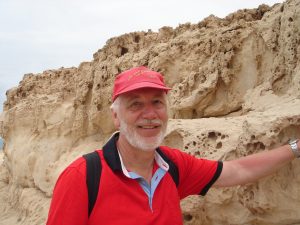GoMRI Research Board Member Jürgen Rullkötter Receives North German Research Award
– December 19, 2012
On November 29th, the research group on BioGeoChemistry of Tidal Flats, a joint project of the University of Oldenburg, the Max Planck Institute of Marine Microbiology in Bremen and the Senckenberg Institute in Wilhelmshaven, won the first North German Research Award. The award honors successful scientific cooperation projects across the federal states and is granted by the ministries of science of the five North German states.
The prize-winning project was run by Professor Jürgen Rullkötter, director of the Institute of Chemistry and Biology of the Marine Environment at the University of Oldenburg. Professor Rullkötter accepted the award and 50,000 Euros on behalf of his research group. Dr. Rullkötter also serves on the Research Board for the Gulf of Mexico Research Initiative.
The German Science Foundation (Deutsche Forschungsgemeinschaft) established the research group on BioGeoChemistry of Tidal Flats (2001-2011) to learn more about the hydrodynamic and biogeochemical processes in tidal flats. “A fundamental knowledge of the physical, biological and chemical processes in the tidal flats is one of the prerequisites to adequately protect this unique landscape and its ecosystem and to better assess the possible influence of climate change and rising sea level”, said Rullkötter.
Intense field and laboratory studies in the backbarrier tidal flats of the island of Spiekeroog (Southern North Sea in Northwest Germany) addressed the hydrographic system as well as the transport of particulate and dissolved organic and inorganic material in the water column, phytoplanktonic biomass production, and the remineralization of the biomass of decayed organisms by microorganisms in the water column and the sand bodies of the tidal flats. The most striking feature of the project is an autonomous time-series station in the tidal channel southwest of Spiekeroog that has continuously collected data on meteorology, currents, sea level, waves, water temperature and salinity, particulates and nutrients in the water, solar irradiation and chlorophyll over the last ten years. Because the inside of the station is accessible down to the sea floor and equipped with a series of flow-through tubes at different water depths, measurements continue also during periods of storm events and drifting ice in winter.
Read more about Dr. Rullkötter’s active involvement and leadership in the scientific community.
The GoMRI Research Board consists of twenty members – ten appointed by BP and ten appointed by the Gulf of Mexico Alliance. The Research Board is the decision-making and oversight body regarding research conducted pursuant to the GoMRI. The role of the Research Board is to ensure the intellectual quality, research effectiveness, and academic independence of the GoMRI programs.
The GoMRI research program is made possible by a grant from BP/The Gulf of Mexico Research Initiative – a 10-year, $500 million independent research program established by an agreement between BP and the Gulf of Mexico Alliance to study the effects of the Deepwater Horizon incident and the potential associated impact of this and similar incidents on the environment and public health.
© Copyright 2010- 2017 Gulf of Mexico Research Initiative (GoMRI) – All Rights Reserved. Redistribution is encouraged with acknowledgement to the Gulf of Mexico Research Initiative (GoMRI). Please credit images and/or videos as done in each article. Questions? Contact web-content editor Nilde “Maggie” Dannreuther, Northern Gulf Institute, Mississippi State University (maggied@ngi.msstate.edu).






